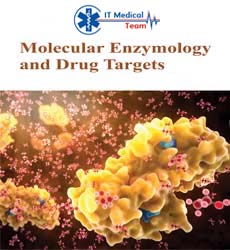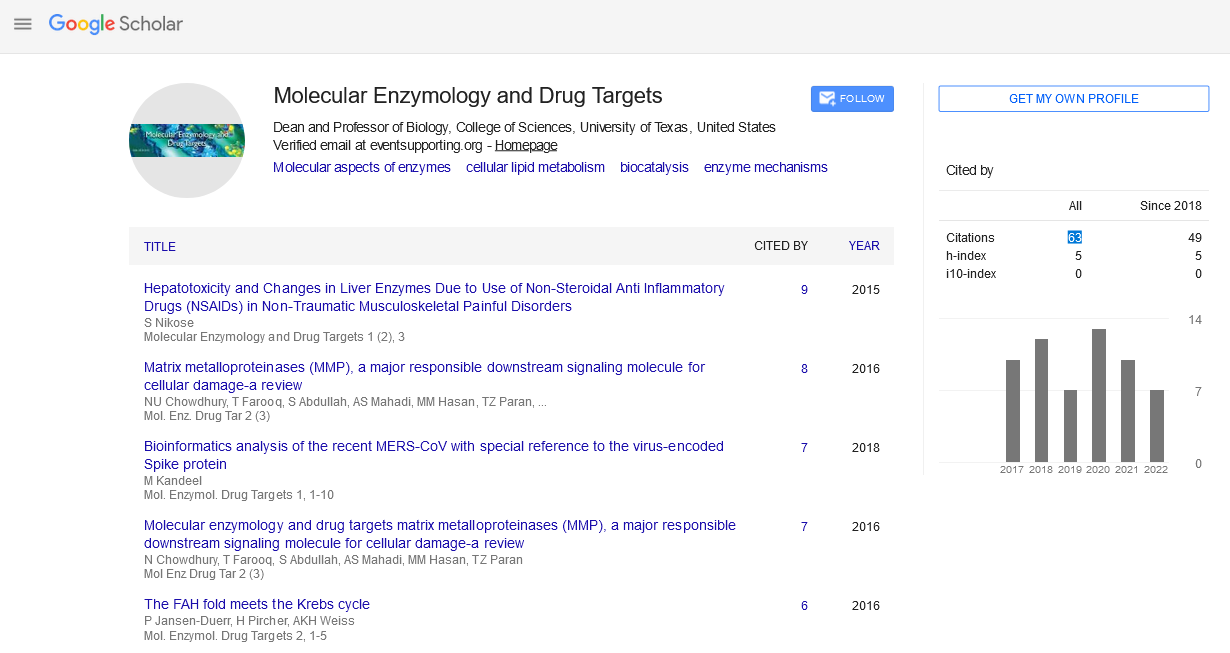Mini Review - (2023) Volume 9, Issue 2
Impact of Ion-Pairing Agents on Hydrophilic-Interaction Liquid Chromatography High-Resolution Mass Spectrometry's Ability to Separate Intact Glycoproteins
Shiva Mishra*
Department of Biological Chemistry, University of Hasanuddin, Indonesia
*Correspondence:
Shiva Mishra, Department of Biological Chemistry, University of Hasanuddin,
Indonesia,
Received: 03-Apr-2023, Manuscript No. Ipmedt-23-13678;
Editor assigned: 05-Apr-2023, Pre QC No. P-13678;
Reviewed: 19-Apr-2023, QC No. Q-13678;
Revised: 21-Apr-2023, Manuscript No. R-13678;
Published:
28-Apr-2023
Abstract
High-resolution separations of glycoforms of glycoproteins that differ in the number of glycans are possible using hydrophilic-interaction liquid chromatography of intact proteins. To maximise the contribution of the hydroxyl groups of the sugars in the glycoprotein, it is necessary to shield the positively charged sites of the proteins with acidic ion-pair reagents in order to get effective separations. Here, we looked at how different IPRs with diverse physico-chemical characteristics, like hydrophobicity and acidity, affected the capillary-scale HILIC separation of intact. The use of fluoroacetic acid, difluoroacetic acid, trifluoroacetic acid, and heptafluorobutyric acid as diluents for sample preparation, solvents for loading samples onto a reversed-phase trap prior to the HILIC separation, and mobile-phase components for HILIC and HILICMS were all examined. To we used an acrylamide-based monolithic column to lessen the impact of ion-exchange interaction with the stationary phase (silica-based). We looked at how the various IPRs affected each phase in the separation of a mixture of proteins with varying sizes and hydrophilicity, as well as the separation of ribonuclease B's five glycoforms. It was established that the sample's IPR content had no impact on the separation or MS detection.
INTRODUCTION
A low concentration of TFA and DFA in the mobile phase
is advantageous, though, as it prevents the formation of
adducts and increases signal intensity [1]. Horseradish
peroxidase, a complex glycoprotein with a molecular
weight of 40 kDa, was efficiently resolved under the
optimal HILIC conditions [2]. Using high in-source
collision energy during the MS analysis is one technique to
lessen the effects that TFA has on the system. However, this
could result in the in-source fragmentation of proteins with
labile structures, which would make it difficult to analyse
them whole [3]. The removal of TFA adducts has been
accomplished using a variety of post-column strategies [4].
The most recent one was described by Wouters and involved
a multi-channel microfluidic system that exchanged TFA
ions for propionic or formic acid by selectively removing
TFA ions [5]. TFA was tried to be replaced with another
IPR or to have its concentration in the mobile phase
decreased in a number of investigations [6]. Tengattini
discovered that a good separation of glycoforms required at
least 0.05% of TFA. Zhang were able to reduce the amount
of TFA by using an updated stationary phase [7]. The silica
particles were modified by coating them with a thick layer
of polyacrylamide to reduce interactions between the free
sialon groups and the cationic groups on the protein [8].
Lardeux recently came to the conclusion that TFA must
be used for HILIC-MS separations after researching
monoclonal antibodies [9]. In this article, we present
findings from a study that intended to reduce the presence
and consequences of TFA on intact proteins detected by
HILIC-MS. We investigated the effects of various IRPs
with various hydrophobicity’s [10]. The sample was loaded
onto a monolithic stationary phase made of acrylamide
using a capillary setup with a trap-and-elute configuration.
With the help of two samples a protein combination and
the five major glycoforms of ribonuclease B the effects of
the various IPRs were assessed. From sample preparation
through MS analysis, every stage of the micro-LC
separation process was considered. Finally, we showed that
our improved procedure may be used to separate a difficult
horseradish-peroxidase (HRP) glycoprotein, enabling
us to keep track of its nine primary glycoforms. Thermo
Fisher Scientific's Ultimate RSLCnano system, located
in Breda, the Netherlands, was used for the LC analyses.
It has a loading-pump system, a ten-port, two-position
valve, and an auto sampler the separation performance
was assessed using the following parameters: peak capacity, retention duration, peak area, and asymmetry. Retention
times showed no discernible trends or changes. Except for
BSA and TfL, which varied slightly because to the more
hydrophobic BSA and TfL, similar asymmetry values were
seen for the various IPRs? We hypothesise that desorption
of the proteins from the trap is a limiting factor and that
the larger the protein, the higher is its retention on the
C4 trap column. Additionally, a decreased retention on the
RP trap-column due to a less hydrophobic loading pump
solvent may result in sample loss.
DISCUSSION
Additionally, recovery values followed a similar pattern,
with no IPR reagent or buffers acting as the loading pump
solvent, High-resolution separations of glycoforms of
glycoproteins that differ in the number of glycans are possible
using hydrophilic-interaction liquid chromatography of
intact proteins. The positively charged protein sites must,
however, be protected by acid-pair reagents in order to
maximise the contribution of the hydroxyl groups of the
sugars in the glycoprotein and achieve effective separations.
Here, we looked at how different IPRs with different
physico-chemical characteristics, like hydrophobicity
and acidity, affected the capillary-scale HILIC separation
of whole proteins. Fluoroacetic acid, difluoroacetic acid
(DFA), trifluoroacetic acid, and heptafluorobutyric acid
were all tested as diluents for sample preparation, solvents
for loading samples onto a reversed-phase trap prior to
the HILIC separation, and mobile-phase components for
HILIC and HILIC-MS. To we employed an acrylamidebased
monolithic column to decrease the contribution of
ion-exchange interaction with the stationary phase. We
looked at how the various IPRs affected each phase in the
separation of a mixture of proteins with varying sizes and
hydrophilicity, as well as the separation of ribonuclease
B's five glycoforms. It was established that the sample's
IPR content had no impact on the separation or MS
detection. A low concentration of TFA and DFA in the
mobile phase is advantageous, though, as it prevents
the formation of adducts and increases signal intensity.
Horseradish peroxidase, a complex glycoprotein with a molecular weight of 40 kDa, was efficiently resolved under
the optimal HILIC conditions. A method for separating
polar chemicals based on hydrophilic partitioning,
hydrogen bonds, dipole-dipole, and ionic interactions is
known as hydrophilic-interaction liquid chromatography.
Mass spectrometry and HILIC are widely combined to
characterise tiny polar compounds and metabolites, and
more recently, these techniques have been expanded to
analyse entire proteins, in particular glycoproteins. A
typical post-translational alteration known as glycosylation
involves the attachment of saccharide chains to the protein.
Glycans are the name given to these chains.
CONCLUSION
These days, polar stationary phases based on silica are used
in HILIC's intact-glycoprotein analysis. With the addition
of an ion-pair reagent, elution is carried out using shallow
linear gradients with acetonitrile and water mixtures. Strong
acids and other IPRs improve separation performance
and lessen band broadening and peak tailing. Furuki
investigated these phenomena in detail in glycopeptides
separations and came to the conclusion that negatively
charged IPR bind to the basic and positively charged
groups of glycopeptides, diminishing the interaction of
the molecule with the stationary phase. In this paper, we
discuss protein capillary HILIC-MS using an ion pair
reagent. Relatively large volumes of samples were loaded
and injected into a monolithic capillary column using an
online trap-column. To evaluate the impact of IPR on
the separation of proteins, studies of IPR in the sample,
loading pump, and mobile phase were conducted. Each
step has been outlined in the three subparagraphs that
follow, and the impact of IPR has been evaluated for each.
The volumes involved appear to have a significant impact
on the IPR's applicability in each stage of the HILIC-UV
study. The final separation is unaffected by the IPR in the
sample, however the loading solvent unexpectedly had a
consistent impact on the protein regions. Finally, the IPR
in the mobile phase exhibits variations in peak forms and
selectivity as would be predicted.
REFERENCES
- Sehgal M, Ladd HJ, Totapally B, et al. Trends in Epidemiology and Microbiology of Severe Sepsis and Septic Shock in Children. Hospital Pediatrics. 2020;10: 1021-1030.
Indexed at, Google Scholar, Crossref
- Song G, Liang G, Liu W, et al. Fungal Co-infections Associated with Global COVID-19 Pandemic: A Clinical and Diagnostic Perspective from China. Mycopathologia. 2020;185: 599-606.
Indexed at, Google Scholar, Crossref
- Nwokolo NC, Boag FC. Chronic vaginal candidiasis Management in the postmenopausal patient. Drugs & Aging. 2000;16: 335-9.
Indexed at, Google Scholar, Crossref
- Akpan A, Morgan R. Oral candidiasis. Postgrad Med J. 2002;78: 455-9.
Google Scholar, Crossref
- Lippi D, Gotuzzo E. the greatest steps towards the discovery of Vibrio cholerae. Clin Microbiol Infect. 2014;20: 191-195.
Indexed at, Google Scholar, Crossref
- Cassells AC. Pathogen and biological contamination management in plant tissue culture: phytopathogens, vitro pathogens, and vitro pests. Plant Cell Culture Protocols. Methods mol Boil. 2012;877: 57-80.
Indexed at, Google Scholar, Crossref
- Belland R, Ouellette S, Gieffers J, et al. Chlamydia pneumoniae and atherosclerosis. Cell Microbiol. 2004;6: 117-27.
Indexed at, Google Scholar, Crossref
- Azoulay E, Russell L, Van de Louw A, et al. Diagnosis of severe respiratory infections in immunocompromised patients. Intensive Care Medicine. 2020;46: 298-314.
Indexed at, Google Scholar, Crossref
- Stevenson TH, Castillo A, Lucia LM, et al. Growth of Helicobacter pylori in various liquid and plating media. Lett Appl Microbiol. 2000;30: 192-6.
Indexed at, Google Scholar, Crossref
- Viale P, Giannella M, Bartoletti M, et al. Considerations About Antimicrobial Stewardship in Settings with Epidemic Extended-Spectrum β-Lactamase-Producing or Carbapenem-Resistant Enterobacteriaceae. Infect Dis Ther. 2015;4: 65-83.
Indexed at, Google Scholar, Crossref





